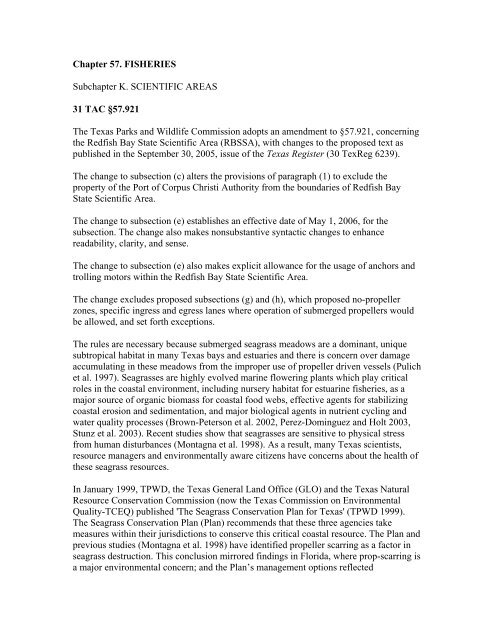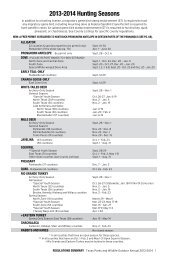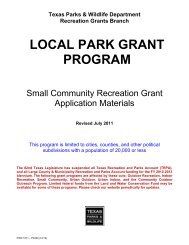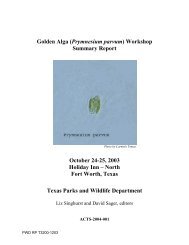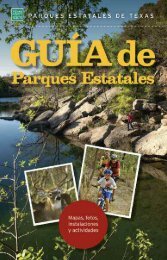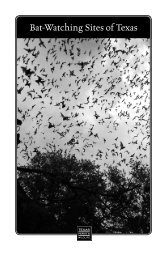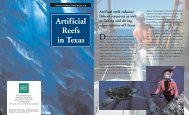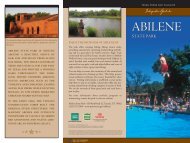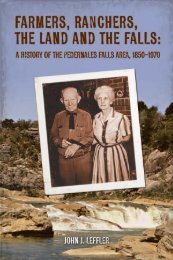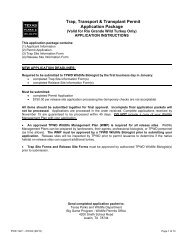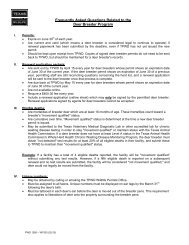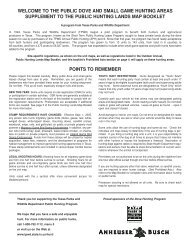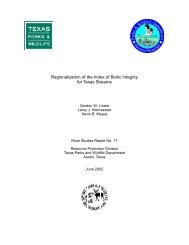Chapter 57. FISHERIES - Texas Parks & Wildlife Department
Chapter 57. FISHERIES - Texas Parks & Wildlife Department
Chapter 57. FISHERIES - Texas Parks & Wildlife Department
Create successful ePaper yourself
Turn your PDF publications into a flip-book with our unique Google optimized e-Paper software.
<strong>Chapter</strong> <strong>57.</strong> <strong>FISHERIES</strong><br />
Subchapter K. SCIENTIFIC AREAS<br />
31 TAC §<strong>57.</strong>921<br />
The <strong>Texas</strong> <strong>Parks</strong> and <strong>Wildlife</strong> Commission adopts an amendment to §<strong>57.</strong>921, concerning<br />
the Redfish Bay State Scientific Area (RBSSA), with changes to the proposed text as<br />
published in the September 30, 2005, issue of the <strong>Texas</strong> Register (30 TexReg 6239).<br />
The change to subsection (c) alters the provisions of paragraph (1) to exclude the<br />
property of the Port of Corpus Christi Authority from the boundaries of Redfish Bay<br />
State Scientific Area.<br />
The change to subsection (e) establishes an effective date of May 1, 2006, for the<br />
subsection. The change also makes nonsubstantive syntactic changes to enhance<br />
readability, clarity, and sense.<br />
The change to subsection (e) also makes explicit allowance for the usage of anchors and<br />
trolling motors within the Redfish Bay State Scientific Area.<br />
The change excludes proposed subsections (g) and (h), which proposed no-propeller<br />
zones, specific ingress and egress lanes where operation of submerged propellers would<br />
be allowed, and set forth exceptions.<br />
The rules are necessary because submerged seagrass meadows are a dominant, unique<br />
subtropical habitat in many <strong>Texas</strong> bays and estuaries and there is concern over damage<br />
accumulating in these meadows from the improper use of propeller driven vessels (Pulich<br />
et al. 1997). Seagrasses are highly evolved marine flowering plants which play critical<br />
roles in the coastal environment, including nursery habitat for estuarine fisheries, as a<br />
major source of organic biomass for coastal food webs, effective agents for stabilizing<br />
coastal erosion and sedimentation, and major biological agents in nutrient cycling and<br />
water quality processes (Brown-Peterson et al. 2002, Perez-Dominguez and Holt 2003,<br />
Stunz et al. 2003). Recent studies show that seagrasses are sensitive to physical stress<br />
from human disturbances (Montagna et al. 1998). As a result, many <strong>Texas</strong> scientists,<br />
resource managers and environmentally aware citizens have concerns about the health of<br />
these seagrass resources.<br />
In January 1999, TPWD, the <strong>Texas</strong> General Land Office (GLO) and the <strong>Texas</strong> Natural<br />
Resource Conservation Commission (now the <strong>Texas</strong> Commission on Environmental<br />
Quality-TCEQ) published 'The Seagrass Conservation Plan for <strong>Texas</strong>' (TPWD 1999).<br />
The Seagrass Conservation Plan (Plan) recommends that these three agencies take<br />
measures within their jurisdictions to conserve this critical coastal resource. The Plan and<br />
previous studies (Montagna et al. 1998) have identified propeller scarring as a factor in<br />
seagrass destruction. This conclusion mirrored findings in Florida, where prop-scarring is<br />
a major environmental concern; and the Plan’s management options reflected
management actions that Florida had successfully implemented to prevent scarring<br />
(Sargent et al. 1995, Ehringer and Anderson 2002, Stowers et al. 2002). Florida has<br />
enacted mandatory measures to prevent propeller scarring of seagrasses in its bays and<br />
estuaries.<br />
TPWD created the RBSSA by rule in 2000 to study seagrass resources and protect them<br />
from the effects of boat propellers. The rule TPWD adopted for the RBSSA in 2000<br />
focused on education and voluntary compliance as the principal means of protecting<br />
seagrass resources. Unfortunately, despite extensive and costly efforts by TPWD over the<br />
past five years, the voluntary approach proved ineffective.<br />
The proposed amendment to §<strong>57.</strong>921 consisted of two different, but complementary,<br />
regulatory approaches to conserve seagrasses within the RBSSA. Of the two, only one<br />
was adopted during the November 3, 2005 meeting of the <strong>Texas</strong> <strong>Parks</strong> and <strong>Wildlife</strong><br />
Commission. The approach that was adopted (proposed §<strong>57.</strong>921(d) - (e)) prohibits the<br />
uprooting of seagrasses throughout the entire area of the RBSSA by submerged<br />
propellers, and defines "seagrass plant" to include the five species prevalent within the<br />
RBSSA. Further, the rule as adopted clarifies that it is not a violation to operate an<br />
electric trolling motor or anchor a vessel within the RBSSA. The rule as adopted also<br />
expands the list of purposes for which signs may be placed in RBSSA to include signs<br />
that mark special zones within the area. The rule as adopted prohibits the uprooting or<br />
digging out of seagrasses by submerged propeller except as allowed under a GLO coastal<br />
lease, or as may result from: (1) using an electric trolling motor, (2) anchoring a vessel<br />
within the area, or (3) other activities permitted under state law. The prohibition would<br />
apply throughout the entire RBSSA (32,144 acres) starting May 1, 2006.<br />
In summary, TPWD in 2000, after extensive research into the issues surrounding seagrass<br />
resources in <strong>Texas</strong>, complied with the "Seagrass Conservation Plan in <strong>Texas</strong>" by<br />
establishing the RBSSA and using a voluntary approach to the protection of seagrass in<br />
the area. Through observation of boaters in the area from TPWD staff it was determined<br />
that the voluntary prop-up areas (zones) were not effective in getting boaters to change<br />
their behavior. Additionally, bottom scarring is still very visible in the area. The lack of<br />
compliance and the inability to see improvement in the area in regards to bottom scarring<br />
led the department to consider other options to protect seagrass in the area. This led to the<br />
adoption of the current rule which prohibits seagrass uprooting in the RBSSA.<br />
Literature Cited<br />
Brown-Peterson, N. J., M. S. Peterson, D. L. Nielson, M. D. Murphy, R. G. Taylor, and J.<br />
R. Warren. 2002. Reproductive biology of female spotted seatrout in the Gulf of Mexico:<br />
differences among estuaries? Environmental Biology of Fishes 63:405-415.<br />
Ehringer, J. N., J. Anderson. 2002. Seagrass Transplanting and Restoration in Tampa<br />
Bay. pages 39-46 in H.S. Greening, ed. Seagrass Management: It's Not Just Nutrients!<br />
2000 Aug 22-24; St. Petersburg, FL. Tampa Bay Estuary Program. 246 p.
Montagna, P. A., S. A. Holt, C. Ritter, S. Herzka, K. F. Binney, and K. H. Dunton. 1998.<br />
Characterization of Anthropogenic and Natural Disturbance on Vegetated and<br />
Unvegetated Bay Bottom Bay Bottom Habitats in the CCBNEP study area- CCBNEP-25<br />
Vol. 1. 108pp.<br />
Perez-Dominguez, R., and G. J. Holt. 2003. How do diel fluctuations in temperature and<br />
dissolved oxygen in seagrass beds affect growth of red drum larvae? Annual Proceedings<br />
of the <strong>Texas</strong> <strong>Chapter</strong> of the American Fisheries Society. page 2.<br />
Pulich, W. Jr., C. Blair, and W. A. White. 1997. Current Status and Historical Trends of<br />
Seagrass in the Corpus Christi Bay National Estuary Program Study Area. Publication<br />
CCBNEP-20. 71pp.<br />
Sargent, F. J., T. J. Leary, D. W. Crewz, and C. R. Kruer. 1995. Scaring of Florida’s<br />
seagrasses: assessment and management options. Florida <strong>Department</strong> of Environmental<br />
Protection. FMRI Technical Report TR-1. 66pp.<br />
Stowers, J. F., E. Fehrmann, A. Squires. 2002. Seagrass scarring in Tampa Bay: impact<br />
analysis and management options. pages 47-54 in H.S. Greening, ed. Seagrass<br />
Management: It's Not Just Nutrients! 2000 Aug 22-24; St. Petersburg, FL. Tampa Bay<br />
Estuary Program. 246 p.<br />
Stunz, G. W., T. J. Minello, and P. S. Levin. 2003. Selection of estuarine nursery habitats<br />
by wild-caught and hatchery-reared juvenile red drum. Annual Proceedings of the <strong>Texas</strong><br />
<strong>Chapter</strong> of the American Fisheries Society. page 1. TPWD Publication. 1999. The<br />
Seagrass Conservation Plan for <strong>Texas</strong>. PWD BK R0400-041. 84pp.<br />
Comments made by the public concerning the proposed rules were presented to the <strong>Texas</strong><br />
<strong>Parks</strong> and <strong>Wildlife</strong> Commission (TPWC). Three public hearings were held October 19<br />
and 20, 2005 in addition to the hearing at the TPWC meeting on November 3, 2005. The<br />
department received comments from the following coastal organizations that were in<br />
support of the proposal: Port Aransas Boatmen, Inc., and the Coastal Bend Guides<br />
Association. The department received comments from the following coastal organizations<br />
that opposed the proposal: Recreational Fishing Alliance, Save Cedar Bayou, The Port of<br />
Corpus Christi Authority, and City By The Seas Property Owner’s Association. The<br />
department received comments from the following coastal organizations that opposed the<br />
"no-prop zones," but supported the other portions of the proposal: Coastal Conservation<br />
Association of <strong>Texas</strong>, and the Rockport Chamber of Commerce. The department received<br />
a total of 232 comments on the proposed regulations which include the organization<br />
comments listed above. Each comment category was totaled individually even when a<br />
single individual may have commented on more than one category (e.g., a single<br />
individual may have been accounted for in 3 separate comment categories). However,<br />
most of the comments received only addressed a portion of the proposal package. Of<br />
those that addressed the complete regulation package 43 were in support of the complete<br />
proposal and 42 expressed that there was no need for the regulations. Additionally, 10<br />
supported only the seagrass and damage definitions while 41 disagreed with that portion
of the proposal. The "no-prop zone" portion of the proposal received 70 comments in<br />
support and 26 disagreed.<br />
Of the 109 that opposed all or part of the proposal, 53 did not elaborate upon their<br />
opposition or give alternatives to the published proposals. The agency’s response to<br />
general, non-specific opposition to the rule as proposed has been addressed earlier in this<br />
preamble and is summarized as: TPWD disagrees with the comments, continues to see<br />
the need for protection of seagrass in the RBSSA, and sees the rules as adopted (which<br />
prohibit uprooting of seagrass in the area) as a reasonable approach to protecting seagrass<br />
while continuing to allow the greatest access to the area.<br />
Of the 109 that opposed all or part of the proposal, 56 offered a specific reason or reasons<br />
for their opposition. Those comments and the agency’s response follow.<br />
COMMENT: Seventeen persons opposed adoption of the rules, stating that the<br />
destruction of seagrass in RBSSA was primarily because the department failed to conduct<br />
an adequate education program for boaters and fishermen in the area.<br />
AGENCY RESPONSE: The agency disagrees and responds that the education program<br />
for boaters and fishermen is ongoing and will always be an important aspect of the efforts<br />
to protect seagrass. Throughout the history of the RBSSA many educational efforts have<br />
been undertaken. Signage on the water and at key boat ramps was established and<br />
maintained as a key educational tool. A boating video was produced and many groups<br />
were contacted and given various educational materials regarding the need for protection<br />
of seagrass in the RBSSA. The continued accumulation of prop-scars within RBSSA<br />
suggests that regardless of the form taken by the education program, individuals<br />
continued to ignore the conservation needs of the seagrass meadows. The voluntary<br />
aspect of the program was not working. The department agrees to work with<br />
organizations within the community to enhance existing education programs and develop<br />
new ones. No changes were made as a result of these comments.<br />
COMMENT: Twelve persons opposed adoption of the rules, stating that the destruction<br />
of seagrass in RBSSA was primarily because the department failed to maintain adequate<br />
signage for boaters and fishermen in the area.<br />
AGENCY RESPONSE: The agency disagrees and responds that damage to seagrass is<br />
not related to how well a no-prop zone was marked. Early in the history of RBSSA<br />
considerable effort and expense was expended to provide and maintain signage on the<br />
voluntary no-prop zones within the area. However, Beau Hardegree (formerly with<br />
TPWD) currently with U. S. Fish & <strong>Wildlife</strong> Service, unpublished data) found that there<br />
was no compliance with the voluntary no-prop zones where there was adequate signage<br />
regardless of the zone (n=212 vessels observed). Nonetheless, the department intends to<br />
work with organizations within the community to improve signage warning the public of<br />
shallow water where seagrass meadows are most vulnerable. No changes were made as a<br />
result of these comments.
COMMENT: Two persons opposed adoption of the rules, stating that a mandatory<br />
boating license should be required of anyone operating a vessel in <strong>Texas</strong> waters and that<br />
license should require a minimum of 8 hours of educational programs about boating<br />
safety and the vulnerability of seagrass meadows in shallow water.<br />
AGENCY RESPONSE: The agency disagrees and responds that damage to seagrass is a<br />
concern of the department and the focus of these rules. However, regulation of boating<br />
licensing and safety is outside the scope of authority provided in <strong>Parks</strong> and <strong>Wildlife</strong><br />
Code, <strong>Chapter</strong> 81, Subchapter F, which is related to the creation and regulation of State<br />
Scientific Areas and, thus, falls outside the scope of these rules. No changes were made<br />
as a result of these comments.<br />
COMMENT: Two persons opposed adoption of the rules, stating that the department<br />
inadequately studied the problem and used inadequate science in concluding that action<br />
was needed.<br />
AGENCY RESPONSE: The agency disagrees and responds that in January 1999,<br />
TPWD, GLO, and TCEQ published 'The Seagrass Conservation Plan for <strong>Texas</strong>' (TPWD<br />
1999) The Seagrass Conservation Plan recommends that these three agencies take<br />
measures within their jurisdictions to conserve this critical coastal resource. The Seagrass<br />
Conservation Plan identified propeller scarring as a factor in seagrass destruction. In<br />
addition, the plan cited many studies that have been conducted that demonstrate extent<br />
and severity of seagrass damage from submerged propellers, and the difficulty and<br />
expense of attempting to restore propeller damaged seagrass. In addition, the department<br />
evaluated numerous studies that have concluded that seagrass meadows play a critical<br />
role in the coastal environment, including nursery habitat for estuarine fisheries, as a<br />
major source of organic biomass for coastal food webs, effective agents for stabilizing<br />
coastal erosion and sedimentation, and major biological agents in nutrient cycling and<br />
water quality processes. And finally, the continued damage to seagrass in the RBSSA<br />
area and the lack of compliance among boaters were documented after the initial rule was<br />
passed in 2000. No changes were made as a result of these comments.<br />
COMMENT: One individual opposed adoption of the rules, stating that the department<br />
inadequately studied the problem and that the shuffling feet of wade fishermen produced<br />
as much damage to seagrass meadows as did submerged propellers.<br />
AGENCY RESPONSE: The agency disagrees and responds that in January 1999,<br />
TPWD, the GLO and TCEQ published 'The Seagrass Conservation Plan for <strong>Texas</strong>'<br />
(TPWD 1999). The Seagrass Conservation Plan recommends that these three agencies<br />
take measures within their jurisdictions to conserve this critical coastal resource. The<br />
Seagrass Conservation Plan identified propeller scarring as a factor in seagrass<br />
destruction. In addition, the plan cited many studies that have been conducted that<br />
demonstrate extent and severity of seagrass damage from submerged propellers, and the<br />
difficulty and expense of attempting to restore propeller damaged seagrass. In addition,<br />
the continued damage to seagrass in the RBSSA area and the lack of compliance among
oaters were documented after the initial rule was passed in 2000. No changes were made<br />
as a result of these comments.<br />
COMMENT: One individual opposed adoption of the rules, stating that the department<br />
inadequately studied the problem and that jet skis sucking grass into their intakes when<br />
running in shallow water produced as much damage to seagrass meadows as did<br />
submerged propellers.<br />
AGENCY RESPONSE: The agency disagrees and responds that in January 1999,<br />
TPWD, the GLO and TCEQ published 'The Seagrass Conservation Plan for <strong>Texas</strong>'<br />
(TPWD 1999). The Seagrass Conservation Plan recommends that these three agencies<br />
take measures within their jurisdictions to conserve this critical coastal resource. The<br />
Seagrass Conservation Plan identified propeller scarring as a factor in seagrass<br />
destruction. In addition, the plan cited many studies that have been conducted that<br />
demonstrate extent and severity of seagrass damage from submerged propellers, and the<br />
difficulty and expense of attempting to restore propeller damaged seagrass. In addition,<br />
the continued damage to seagrass in the RBSSA area and the lack of compliance among<br />
boaters were documented after the initial rule was passed in 2000. No changes were made<br />
as a result of these comments.<br />
COMMENT: One individual opposed adoption of the rules, stating that the department<br />
inadequately studied the problem and that this approach had been tried elsewhere and it<br />
did not produce the desired results.<br />
AGENCY RESPONSE: The agency disagrees and responds that in January 1999,<br />
TPWD, the GLO and TCEQ published 'The Seagrass Conservation Plan for <strong>Texas</strong>'<br />
(TPQD 1999). The Seagrass Conservation Plan recommends that these three agencies<br />
take measures within their jurisdictions to conserve this critical coastal resource. The<br />
Seagrass Conservation Plan identified propeller scarring as a factor in seagrass<br />
destruction. In addition, the plan cited many studies that have been conducted that<br />
demonstrate extent and severity of seagrass damage from submerged propellers, and the<br />
difficulty and expense of attempting to restore propeller damaged seagrass. The<br />
conclusion that propeller scarring is a factor in seagrass destruction mirrored findings in<br />
Florida, where prop-scarring is a major environmental concern; and the Plan’s<br />
management options reflected management actions that Florida had successfully<br />
implemented to prevent scarring (Sargent et al. 1995, Ehringer and Anderson 2002,<br />
Stowers et al. 2002). And finally, the continued damage to seagrass in the RBSSA area<br />
and the lack of compliance among boaters were documented after the initial rule was<br />
passed in 2000. No changes were made as a result of these comments.<br />
COMMENT: One individual opposed adoption of the rules, stating that lower fishing<br />
limits and closed seasons should be used to reduce boating traffic in the area.<br />
AGENCY RESPONSE: The agency disagrees and responds that PWC <strong>Chapter</strong> 61 directs<br />
the Commission to provide reasonable and equitable access to wildlife resources and to<br />
deal effectively with changing conditions to prevent depletion or waste. In this chapter,
"Waste" means the failure to provide for the regulated harvest of surplus wildlife<br />
resources when that harvest would allow, promote, or optimize a healthy and selfsustaining<br />
population of a species. The agency believes that damage to seagrass meadows<br />
is the result of the way vessels are operated in RBSSA and can be addressed without<br />
reducing bag limits and closing seasons. If the bag limits in the area were reduced and it<br />
resulted in fewer people fishing in the area, there would be economic losses to the local<br />
economy that would not be justified based on protection of seagrass or based on the<br />
biological productivity of fish in the area. No changes were made as a result of this<br />
comment.<br />
COMMENT: One individual opposed adoption of the rules, stating that instead the<br />
department should reduce or stop the dumping of dredge spoil into seagrass meadows.<br />
AGENCY RESPONSE: The agency disagrees and responds that the department does not<br />
have the authority to regulate the deposition of spoil. Dredging and deposition of spoil is<br />
regulated by the U. S. Corps of Engineers (CORPS) under the Rivers and Harbors Act<br />
and under section 404 of the Clean Water Act, and by the GLO (i.e., which is the owner<br />
of the bay bottom), or, in certain bays and channels, a navigational district or harbor/port<br />
authority who owns the bottom in lieu of the GLO. TPWD’s role in the process is only to<br />
review and comment on permits issued by the CORPS. No changes were made as a result<br />
of this comment.<br />
COMMENT: One individual opposed adoption of the rules, stating that regulations<br />
should be promulgated for a much smaller area than RBSSA.<br />
AGENCY RESPONSE: The agency disagrees and responds that seagrass meadows exist<br />
in discontinuous patches along the whole <strong>Texas</strong> coast. The management strategy protects<br />
seagrass throughout the entire RBSSA which constitutes the largest concentration of this<br />
type of marine habitat found anywhere along the coast. Through protecting the larger area<br />
of the RBSSA the rule will also protect smaller more concentrated patches of seagrass<br />
within the RBSSA. The department responds that protecting only a small portion of the<br />
area would be inadequate and inappropriate when concern is for the meadows of the<br />
whole area. No changes were made as a result of this comment.<br />
COMMENT: One individual opposed adoption of the rules, stating that the public was<br />
inadequately notified to develop and make comments on the proposals.<br />
AGENCY RESPONSE: The agency disagrees and responds that discussions in the area<br />
predate the publication of the "The Seagrass Conservation Plan" (TPWD 1999) and the<br />
establishment of the RBSSA in 2000. The results of the information gathered from 2000<br />
until now were scoped with stakeholders in the area beginning April 2005 and with the<br />
Seagrass Advisory Committee in May 18, 2005. Additionally, the proposal was publicly<br />
presented to the Regulations Committee August 24, 2005, published in the <strong>Texas</strong> Register<br />
September 20, 2005, and distributed through a news release September 26, 2005<br />
describing the proposals and notifying the public of Public Hearings to be held in San<br />
Antonio, Rockport, and Corpus Christi. The news release further gave contact names and
other alternative ways in which the public could comment on the proposals. The fact that<br />
232 comments were made suggests that there was adequate notification of the proposed<br />
action. No changes were made as a result of this comment.<br />
COMMENT: One individual opposed adoption of the rules, stating that regulations<br />
prohibiting uprooting of seagrass plants would force fishermen to use only jet skis and air<br />
boats.<br />
AGENCY RESPONSE: The agency disagrees and responds that the intent of the<br />
regulation is aimed at propeller driven vessels that run in water too shallow for their draft<br />
and uproot seagrass plants as a result. While one way of avoiding such uprooting would<br />
be to use a jet ski or air boat, it certainly isn’t the only way. Use of deep water channels<br />
within seagrass meadows as run lanes; drifting, poling, or trolling with an electric trolling<br />
motor between deep water channels; and tilting a motor to prevent contact with the<br />
bottom are all proven methods of avoiding uprooting of seagrass without needing to<br />
resort to using jet skis or air boats. No changes were made as a result of this comment.<br />
COMMENT: One individual opposed adoption of the rules, stating that regulations<br />
prohibiting uprooting of seagrass plants would require certain disabled individuals to buy<br />
specialized equipment in order to navigate the RBSSA.<br />
AGENCY RESPONSE: The agency disagrees and responds that the intent of the<br />
regulation is aimed at propeller driven vessels that run in water too shallow for their draft<br />
and uproot seagrass plants as a result. Use of deep water channels within seagrass<br />
meadows as run lanes; drifting, poling, or trolling with an electric trolling motor between<br />
deep water channels; and tilting a motor to prevent contact with the bottom are all proven<br />
methods of avoiding uprooting of seagrass. This is true regardless of whether a fisherman<br />
had a disability or not. No changes were made as a result of this comment.<br />
COMMENT: One individual opposed adoption of the rules, stating that regulations<br />
prohibiting uprooting of seagrass plants were not needed because there was more<br />
seagrass now than there ever had been.<br />
AGENCY RESPONSE: The agency disagrees and responds that in January 1999,<br />
TPWD, the GLO and TCEQ published 'The Seagrass Conservation Plan for <strong>Texas</strong>'<br />
(TPWD 2000). The Seagrass Conservation Plan recommends that these three agencies<br />
take measures within their jurisdictions to conserve this critical coastal resource. The<br />
Seagrass Conservation Plan identified propeller scarring as a factor in seagrass<br />
destruction. In addition, the plan cited many studies that have been conducted that<br />
demonstrate extent and severity of seagrass damage from submerged propellers, and the<br />
difficulty and expense of attempting to restore propeller damaged seagrass. The fact that<br />
propeller scarring is accumulating, means that there is more exposed bottom without<br />
seagrass so that there cannot be, therefore, more seagrass than there was before there was<br />
propeller scarring. No changes were made as a result of this comment.
COMMENT: One individual opposed adoption of the rules, stating that the department<br />
inadequately studied the problem and that if staff would inspect seagrass meadows at<br />
night they would find them full of fish.<br />
AGENCY RESPONSE: The agency disagrees and responds that in January 1999,<br />
TPWD, the GLO and TCEQ published 'The Seagrass Conservation Plan for <strong>Texas</strong>'<br />
(TPWD 1999). The Seagrass Conservation Plan recommends that these three agencies<br />
take measures within their jurisdictions to conserve this critical coastal resource. The<br />
Seagrass Conservation Plan identified propeller scarring as a factor in seagrass<br />
destruction. In addition, the department evaluated numerous studies that have concluded<br />
that seagrass meadows play a critical role in the coastal environment, including nursery<br />
habitat for estuarine fisheries, as a major source of organic biomass for coastal food<br />
webs, effective agents for stabilizing coastal erosion and sedimentation, and major<br />
biological agents in nutrient cycling and water quality processes. And finally, the<br />
continued damage to seagrass in the RBSSA area and the lack of compliance among<br />
boaters were documented after the initial rule was passed in 2000. There is no dispute<br />
that seagrass meadows are important to marine life and that fish would be expected to use<br />
these areas. The issue is the damage done to these seagrass meadows from submerged<br />
propellers. No changes were made as a result of these comments.<br />
COMMENT: One individual representing the Port of Corpus Christi Authority (PCCA)<br />
opposed adoption of the rules, stating that land belonging to PCCA had been<br />
inappropriately included in RBSSA and should be removed from the regulation.<br />
AGENCY RESPONSE: The agency agrees and responds that the department was<br />
unaware that (a) the land in question belonged to the PCCA; (b) that PCCA would be<br />
opposed to protecting seagrass meadows on their property; or that (c) the designation of<br />
RBSSA in anyway inhibited any other use of the land to PCCA. PCCA did not comment<br />
on the 2000 proposal or the renewal proposal of RBSSA in 2005, both of which included<br />
this submerged land. In response to the comment, the coordinates on the south boundary<br />
of RBSSA have been amended to exclude this land.<br />
COMMENT: One individual opposed adoption of the "general definitions" portion of the<br />
rules, stating that regulations prohibiting uprooting of seagrass plants were too vague and<br />
needed to include "submerged propeller" to clarify specifically what was prohibited.<br />
AGENCY RESPONSE: The agency agrees and responds that the intent of the regulation<br />
is aimed at propeller driven vessels that run in water too shallow for their draft and uproot<br />
seagrass plants as a result. Language was added to exempt trolling motors and anchoring,<br />
and to specifically identify damage done by a "submerged propeller" as the focus of the<br />
prohibitions as a result of this comment.<br />
COMMENT: One individual opposed adoption of the "general definitions" portion of the<br />
rules, stating that regulations prohibiting uprooting of seagrass plants were too vague and<br />
would prevent vessel operators from anchoring in the RBSSA.
AGENCY RESPONSE: The agency agrees and responds that the intent of the regulation<br />
is aimed at propeller driven vessels that run in water too shallow for their draft and uproot<br />
seagrass plants as a result. Language was added to exempt trolling motors and anchoring,<br />
and to specifically identify damage done by a "submerged propeller" as the focus of the<br />
prohibitions as a result of this comment.<br />
COMMENT: Nine individuals opposed adoption of the "no-prop zones" portion of the<br />
rules, while stating various reasons why they should not be implemented.<br />
AGENCY RESPONSE: The "no-prop zones" were not adopted by the TPWC.<br />
The amendment is adopted under <strong>Parks</strong> and <strong>Wildlife</strong> Code, §81.501, which authorizes the<br />
commission to create state scientific areas for the purposes of education, scientific<br />
research, and preservation of flora and fauna of scientific or educational value,<br />
§81.502(c), which authorizes adoption of rules and regulations necessary for the<br />
management and protection of scientific areas, and <strong>Chapter</strong> 13, Subchapter B, which<br />
authorizes the commission to adopt regulations governing state scientific areas.<br />
§<strong>57.</strong>921.Redfish Bay State Scientific Area.<br />
(a) Purpose: The Redfish Bay State Scientific Area is established for the purpose of<br />
education, scientific research, and preservation of flora and fauna of scientific or<br />
educational value.<br />
(b) Term: July 1, 2005 through June 30, 2010.<br />
(c) Boundaries:<br />
(1) 27 59.538N; 097 3.858W (Northern extremity of island forming northern boundary of<br />
Estes Cove);<br />
(2) 27 59.232N; 097 4.434W (Intersection of Gulf Intracoastal Waterway (GIWW) and<br />
Mouth of Cove Harbor);<br />
(3) 27 55.986N; 097 6.804W (GIWW at Rocky Ridge);<br />
(4) 27 53.880N; 097 8.088W (intersection of GIWW and Aransas Pass Shrimp Boat<br />
Channel);<br />
(5) 27 53.058N; 097 8.502W (Intersection of GIWW and Brown and Root Channel);<br />
(6) 27 52.32N; 097 9.486W (Intersection of GIWW and mouth of Redfish Bay<br />
Terminal);<br />
(7) 27 49.483N; 097 11.255W (A point near the southern extremity of Dagger Island<br />
where the Corpus Christi Ship Channel and the GIWW intersect);
(8) 27 50.489N; 097 6.619W (A point north of the southwest arm of Harbor Island);<br />
(9) 27 50.613N; 097 6.614W (A point northwest of the previous point , north of the<br />
southwest arm of Harbor Island);<br />
(10) 27 50.860N; 097 5.315W (A point north of the southeast portion of Harbor Island);<br />
(11) 27 50.439N; 097 4.841W (A point in the Corpus Christi Channel southeast of<br />
Harbor Island);<br />
(12) 27 50.745 N; 097 3.66 W (A point on Harbor Island at the intersection of Aransas<br />
Shrimp Boat Channel and Corpus Christi Ship Channel);<br />
(13) 27 52.420 N; 097 2.470 W (A point in Lydia Ann Channel);<br />
(14) 27 55.020 N; 097 03.460 W (East of the mouth of Corpus Christi Bayou).<br />
(d) No person may move, remove, deface, alter, or destroy any sign, depth marker or<br />
other informational signage placed by the department to delineate boundaries of the<br />
Redfish Bay State Scientific Area or to designate specific zones within the area.<br />
(e) This subsection is effective May 1, 2006.<br />
(1) In this section, "seagrass plant" means individuals from the following marine<br />
flowering plant species: Clover Grass (Halophila engelmanni), Manatee Grass<br />
(Syringodium filiformis), Shoalgrass (Halodule beaudettei), Turtle Grass (Thalassia<br />
testudinum), and Widgeon Grass (Ruppia maritima).<br />
(2) Within the Redfish Bay State Scientific Area, no person shall cause or allow any<br />
rooted seagrass plant to be uprooted or dug out from the bay bottom by a submerged<br />
propeller, except as may be permitted by a coastal lease issued by the <strong>Texas</strong> General<br />
Land Office or otherwise permitted under state law.<br />
(3) Notwithstanding paragraph (2) of this subsection, it is not a violation to:<br />
(A) anchor a vessel within the Redfish Bay State Scientific Area; or.<br />
(B) use electric trolling motors within the Redfish Bay State Scientific Area.<br />
(f) The penalty for violation of this section is prescribed by <strong>Parks</strong> and <strong>Wildlife</strong> Code,<br />
§13.112.<br />
This agency hereby certifies that the adoption has been reviewed by legal counsel and<br />
found to be a valid exercise of the agency's legal authority.<br />
Filed with the Office of the Secretary of State on March 17, 2006.
TRD-200601687<br />
Ann Bright<br />
General Counsel<br />
<strong>Texas</strong> <strong>Parks</strong> and <strong>Wildlife</strong> <strong>Department</strong><br />
Effective date: April 6, 2006<br />
Proposal publication date: September 30, 2005<br />
For further information, please call: (512) 389-4775


